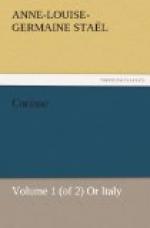Facing these triumphal arches are the ruins of the temple of Peace built by Vespasian; it was so decorated with brass and with gold, internally, that when consumed by fire, the streams of burning metal that flowed from it extended even to the Forum. Lastly, the Coliseum, the most beautiful ruin of Rome, terminates this noble enclosure, which embraces all history in its compass. This superb edifice, of which only the stones remain, stript of the gold and the marble, served as an amphitheatre for the combats of the gladiators, with wild beasts. It was thus that the Roman people were amused and deceived by strong emotions, when natural sentiments could no longer soar. The entrance to the Coliseum is by two doors, one consecrated to the victors, and by the other were carried out the dead: strange contempt for the human race, which made the life or death of man dependent upon the pastime of a public spectacle! Titus, the best of emperors, dedicated the Coliseum to the Roman people,—and these admirable ruins bear such fine traits of magnificence and genius, that we are led into an illusion on the subject of true greatness, and tempted to grant that admiration to the masterpieces of art, which is only the due of monuments consecrated to generous institutions.
Oswald did not indulge in that admiration which Corinne felt in contemplating these four galleries; these four edifices, rising one upon another; this medley of pomp and barbarism, which at once inspires respect and compassion. He beheld in these scenes nothing but the luxury of the master, and the blood of the slaves, and felt indignant at the arts which, regardless of their aim, lavish their gifts upon whatever object they may be destined for. Corinne endeavoured to combat this disposition:—“Do not,” said she, to Lord Nelville, “carry the rigour of your principles of morality and justice into the contemplation of the Italian monuments; they, for the most part, recall, as I have told you, rather the splendour, the elegance of taste of ancient forms, than the glorious epoch of Roman virtue. But do you not find some traces of the moral greatness possessed by the first ages, in the gigantic luxury of the monuments which have succeeded them? Even the degradation of the Roman people still commands respect: the mourning of her liberty covers the world with wonders, and the genius of ideal beauty seeks to console man for the true and real dignity which he has lost. Behold those immense baths, open to all those who were willing to taste oriental voluptuousness—those circuses destined for the elephants which were brought there to combat with tigers, and those aqueducts which in a moment converted the amphitheatre into a lake, where galleys too fought in their turn, and crocodiles appeared where lions were seen before:—such was the luxury of the Romans when luxury was their pride! Those obelisks which were brought from Egypt, stolen from African shades, in order to adorn the Roman sepulchres; that population of statues which formerly existed in Rome cannot be looked upon in the same light as the useless pageantry of the Asiatic despots: it is the Roman genius which conquered the world, and to which the arts have given an external form. There is something supernatural in this magnificence, and its poetical splendour makes us forget its origin and its aim.”




